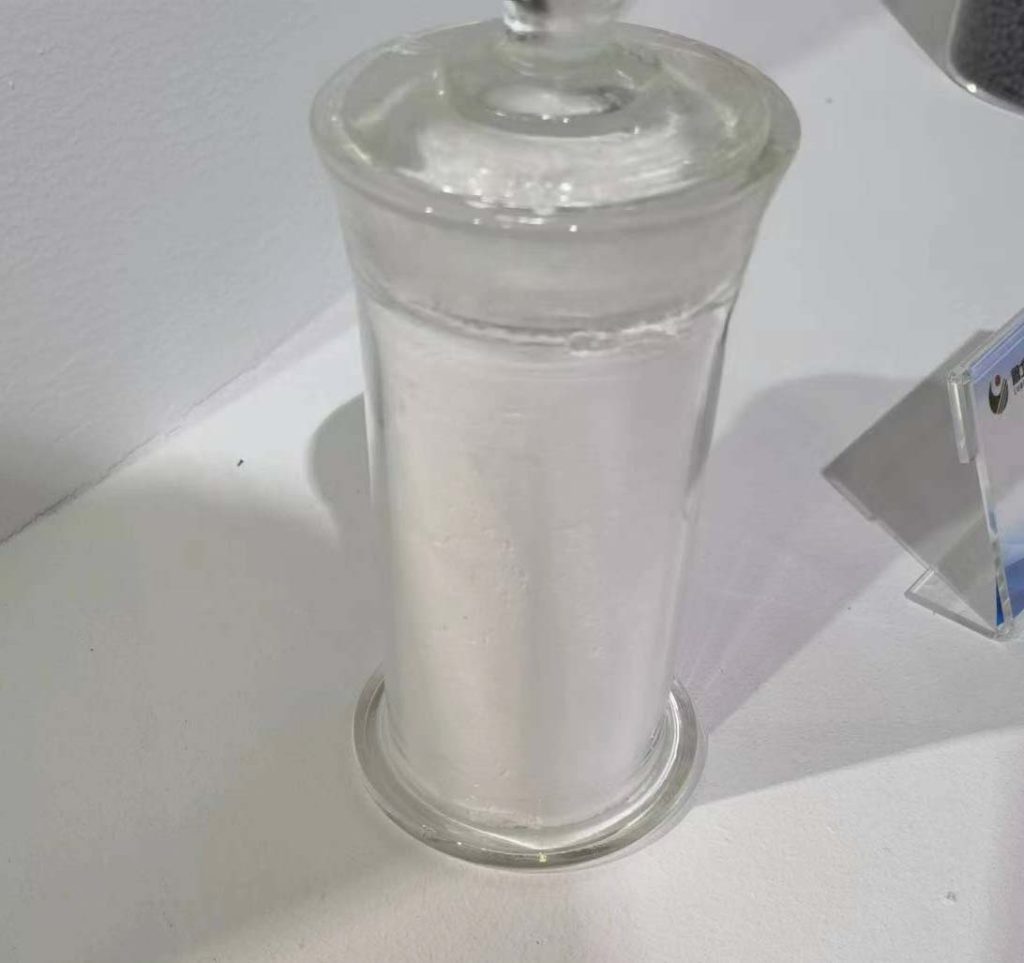Hydroxyethylcellulose
Hydroxyethylcellulose is a different products with Hydroxy Propyl Methyl Cellulose, Although they all have similar thickening properties. Compared to Hydroxypropylmethylcellulose,hydroxyethylcellulose has a significant difference in using melting point and performance.
Hydroxyethylcellulose (HEC) stands as a polymer, origin to a meticulous process that involves cellulose, a fundamental polysaccharide found abundantly in nature. Derived from this biopolymer, hydroxyethyl cellulose emerges as a hydroxyethyl ether variant. The synthesis of this unique compound takes shape through a series of carefully orchestrated steps, where cellulose takes center stage.
Hydroxyethyl cellulose or HEC is a gelling agent and thickening agent derived from cellulose, finds widespread utilization across multiple industries. From cosmetics to household cleaning solutions, its impact is noteworthy. This polymer, denoted as Hydroxyethylcellulose (HEC), emerges through a process wherein cellulose undergoes treatment with sodium hydroxide and subsequent reaction with ethylene to yield a hydroxyethyl ether derivative.
In specific contexts, hydroxyethyl-cellulose proves invaluable. Within ophthalmic formulations, it serves as a viscosity-enhancing agent, extending the duration of corneal contact. Its capabilities as a gelling and thickening agent, stemming from its cellulose origin, are further accentuated by its role as a rheology modifier. This non-ionic, water-soluble polymer assumes significance within aqueous cosmetic and personal care formulations, functioning as a potent thickening agent.
Moreover, the application spectrum broadens as hydroxyethyl cellulose contributes to the development of biostructures. However, it’s vital to underscore safety precautions due to its combustible nature. The fine dispersion of its particles raises the potential for explosive mixtures in air. Therefore, it’s imperative to avoid open flames and adopt a closed system, incorporating dust explosion-proof electrical equipment and lighting to mitigate risks effectively.
What is hydroxyethylcellulose ?
Origin
The transformation of cellulose into hydroxyethyl-cellulose (HEC) begins with a treatment involving sodium hydroxide, a crucial chemical component in the reaction. This treatment instigates a sequence of changes that set the foundation for the final compound. Subsequently, ethylene oxide enters the scene, becoming an essential catalyst in the reaction chain. Through the interaction with ethylene oxide, the hydroxyethyl group becomes integrated into the cellulose structure, imparting distinctive properties that characterize HEC.
Cellulose, the primary source material for HEC, constitutes a polysaccharide renowned for its prevalence in various natural settings. It forms an integral part of cell walls in plants and remains present in wood and cotton, underpinning the structural integrity of these organic entities. This intrinsic connection to cellulose underscores the biologically derived nature of hydroxyethyl cellulose.
Other Identifiers
Synonymous with its origin material cellulose, hydroxyethyl cellulose takes on different identities that reflect its molecular modifications. One identifier is hydroxyethyl ether, means the incorporation of hydroxyethyl groups into the cellulose structure. This augmentation results in the compound known as hydroxyethylcellulose.
Further delineating its variations, the compound is also recognized as 2-Hydroxyethyl cellulose. Commercially, the compound is known by brand names such as Hyetellose and Natrosol. In the context of regulatory standards and identification hydroxyethyl-cellulose CAS number is 9004-62-0. This alphanumeric code serves as a universal reference in scientific literature, databases, and regulatory documentation.
In the domain of food additives, hydroxyethyl-cellulose may also be represented by the E number E1525. This numerical designation is part of the European Union’s system for categorizing food additives, providing clarity about its use as an additional chemical component.
Chemical and Physical Properties
In terms of appearance and sensory attributes, Hydroxyethylcellulose HEC presents itself as a distinctive white, free-flowing powder. This coloration underscores its purity and highlights its fine particulate nature. Notably, it carries no discernible odor and possesses a tastelessness that is crucial in applications where flavor neutrality is desired.
The compound demonstrates a defined browning temperature range, specifically between 205 and 210 degrees Celsius. Hydroxyethyl cellulose (HEC) dissolves in both hot and cold water, enabling its incorporation into various aqueous formulations regardless of temperature. Additionally, it displays a partial solubility in acetic acid, opening avenues for specialized applications involving this acidic medium. In contrast, HEC remains insoluble in alcohol, delineating a distinct boundary in terms of its compatibility with different solvents.
Operating at a neutral pH of 7, hydroxyethyl cellulose (HEC) maintains a balanced position on the pH scale. It also has nonionic behavior contributes to the compound’s exceptional stability, compatibility, and overall utility. Also, hydroxyethylcellulose (HEC) is categorized as a water-soluble cellulose ether.
What is Hydroxyethylcellulose Used For?
hydroxyethylcellulose in lube
Hydroxyethyl-cellulose (HEC) takes on a pivotal role as a water-binding agent. This attribute enables it to retain moisture effectively, a critical quality for formulations like moisturizers, lotions, and creams. Moreover, its exceptional thickening ability adds a luxurious texture to cosmetic formulations, enhancing user experience across a spectrum of products, from shampoos to facial cleansers.
The water-binding capabilities of HEC play a crucial role in maintaining consistent moisture levels in oral and topical medications. Its role extends to enhancing the viscosity of liquid medications, contributing to controlled dosing and ease of administration. By ensuring uniform dispersion, HEC contributes to the efficacy and stability of pharmaceutical formulations.
The construction industry benefits significantly from Hydroxyethylcellulose HEC’s thickening prowess. Incorporated into building materials, including paints, coatings, and adhesives, HEC lends enhanced consistency and viscosity, facilitating smooth application processes. Its ability to retain water within mixtures is particularly valuable in cement-based applications, contributing to optimal workability and setting characteristics.
The adhesive industry also leverages the capabilities of HEC, utilizing it as a thickening agent to improve the viscosity of adhesive compositions. This enhancement contributes to the ease of application, adhesive strength, and the durability of bonded materials, ensuring lasting and reliable adhesion | hydroxyethylcellulose in lube.
What Does Hydroxyethylcellulose Do in a Formulation?
One of the standout functions of HEC within formulations is its ability to alleviate skin irritation. Through its gentle and non-irritating nature, HEC becomes a valuable component in products aimed at soothing and nurturing the skin. This quality is of paramount importance in personal care and cosmetic formulations, where skin comfort is a top priority.
Hydroxyethylcellulose HEC, as a polysaccharide derivative, boasts a rich spectrum of properties that significantly impact formulations. Its gel-thickening ability contributes to the desired consistency and texture of products, lending a luxurious feel that enhances user experience. The emulsifying characteristic allows HEC to facilitate the blending of ingredients that would otherwise separate, contributing to product stability
HEC also exhibits bubble-forming properties, which are particularly relevant in formulations where foaming or bubbling is desired, such as in cleansing products. Simultaneously, its water-retaining capability ensures prolonged moisture retention, thereby enhancing the hydrating efficacy of products, especially in moisturizers and lotions.
Beyond its cosmetic applications, it serves as an adsorbent, facilitating the binding and stabilization of various active pharmaceutical ingredients. Additionally, HEC functions as a glidant, ensuring the smooth flow of powdered medications, a crucial detail for accurate dosing. Its role as a drug solvent and suspending agent enhances the solubility and uniform distribution of pharmaceutical compounds within formulations.
when you choose Hydroxypropyl Methylcellulose HPMC and HEC, You’d better first ask yourself clearly about the specific application field and the year you want, so that we can help you make the correct recommendation.
Method for Dissolving HEC | Hydroxyethylcellulose in cosmetics
The process of dissolving Hydroxyethylcellulose (HEC) is characterized by its excellent solubility in both cold and hot water. HEC exhibits remarkable versatility in its solubility, allowing it to form aqueous solutions that remain stable across various temperature conditions. These solutions retain their fluid consistency without undergoing the gelation process, whether subjected to high or low temperatures. This unique property makes HEC a valuable compound for numerous applications that require consistent fluidity regardless of environmental conditions.
One of the notable attributes of HEC is its classification as a nonionic cellulose ether. This classification signifies that HEC lacks a net electric charge in its molecular structure, resulting in its neutral behavior when dissolved in water. This nonionic nature is instrumental in preserving the chemical integrity of HEC across a broad spectrum of pH levels. Whether in acidic, neutral, or alkaline environments, HEC retains its chemical composition and physical characteristics, thus ensuring its stability and functionality in various formulations.
In both research and practical applications, Hydroxyethylcellulose HEC’s stability across pH ranges contributes to its reliability in diverse industries such as pharmaceuticals, cosmetics, food production, and construction. The ability of HEC to maintain its structure and properties in varying pH conditions allows
Hydroxypropyl Methyl Cellulose is completely different with HEC.
High Quality HEC Supplier Modern Paint and Coatings
The significance of Hydroxyethyl cellulose (HEC) as a high-quality supplier to the modern paint and coatings industry is not limited solely to pharmaceutical and personal care manufacturing. Beyond its established applications in these fields, Hydroxyethylcellulose HEC emerges as a crucial additive that imparts exceptional thickening and rheological properties to paint and coating formulations, thereby elevating their overall application characteristics and performance outcomes.
Specifically, HEC’s role in the realm of paint and coatings extends to enhancing the properties of materials such as gypsum, as well as the associated bonding and retention aspects. When applied to the realm of gypsum-related products, such as painting gypsum and gypsum putty, Hydroxyethylcellulose HEC exhibits its transformative influence. The incorporation of HEC into these formulations yields tangible benefits, notably in terms of water retention and bonding strength.
The utilization of Hydroxyethylcellulose HEC within the context of paint and coating manufacturing showcases its versatility as an additive that extends beyond its well-known applications. By imbuing paint and coating formulations with superior thickening and rheological characteristics, Hydroxyethylcellulose HEC contributes to the creation of products that possess enhanced flow, coverage, and adherence properties. Moreover, its adoption in gypsum-related materials demonstrates its capacity to optimize water retention and bonding strength.
Obtain premium-grade Hydroxyethyl cellulose (HEC) with utmost confidence through Tripletchem, ensuring access to a superior quality additive that guarantees exceptional performance across a multitude of applications.
If you want to buy hydroxyethylcellulose HEC or Hydroxypropyl Methylcullulose, pls feel free to contact us. We would like to quote you stable quality and competitive price. Thanks.


